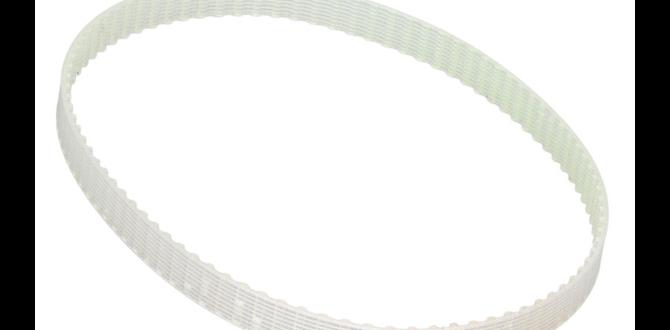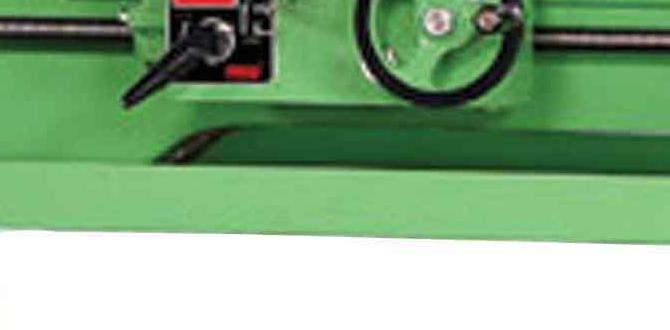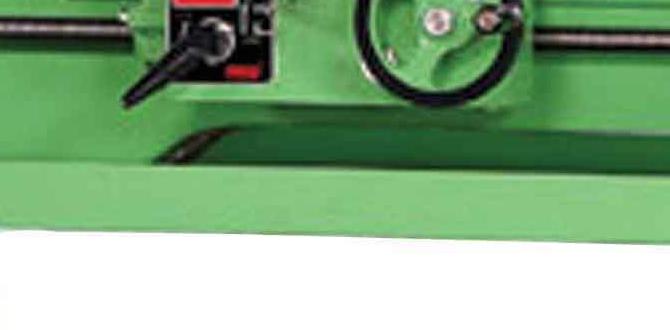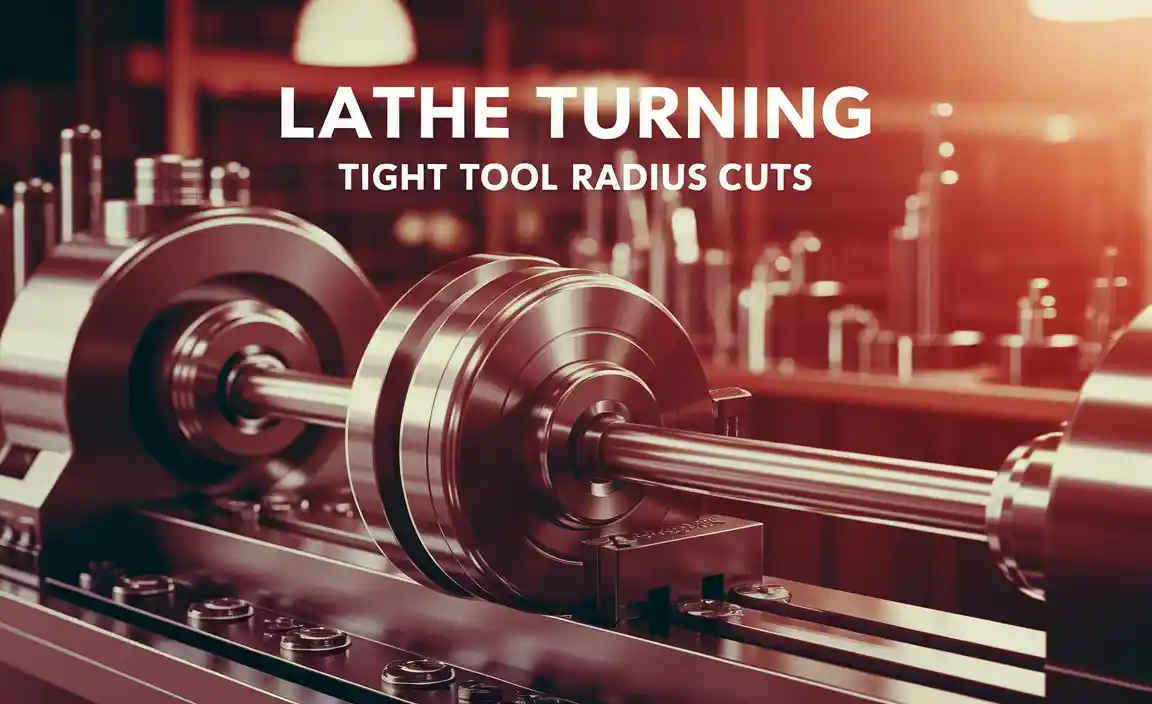A taper attachment for your lathe is a proven essential tool for creating angled surfaces and cones accurately, saving you time and frustration on many projects. It’s a simple yet powerful accessory that significantly expands your lathe’s capabilities, making complex cuts much easier for beginners and experienced machinists alike. Learn how it works and why you need one.
Ever stared at a part you need to turn that has a gradual slope, or a cone, and felt a knot of frustration? Maybe you’ve tried freehanding it, only to end up with an inconsistent angle or hours of sanding to fix it. Creating tapers on a lathe can be tricky, especially when you’re just starting out. Many beginners shy away from these jobs, thinking they require advanced skills. But what if I told you there’s a reliable tool that makes tapping simple, accurate, and repeatable? It’s called a taper attachment for your lathe, and it’s a game-changer for your workshop.
This handy accessory is designed to guide your cutting tool at a specific angle, allowing you to produce smooth, precise tapers without the guesswork. Whether you’re making parts for a model, crafting custom hardware, or just want to add a professional touch to your projects, a taper attachment will quickly become one of your most valuable tools. Let’s dive into what it is, how it works, and why it’s such a celebrated piece of equipment for any machinist.
What Exactly is a Taper Attachment for a Lathe?
At its core, a taper attachment for a lathe is a specialized device that attaches to your lathe’s carriage. Its primary function is to automatically move your tool bit along a predetermined angle as the carriage feeds. Think of it as an automated guide for your cutting tool, ensuring that the movement is perfectly straight and at the exact angle you set. This is crucial for creating tapers – those angled surfaces that are common in many mechanical parts, such as shafts, tool holders, and decorative elements.
Instead of manually adjusting the compound rest for each pass, which is tedious and prone to error, the taper attachment takes over this job. It consists of a long, graduated guide bar that pivots relative to the lathe bed. A nut or block connected to the carriage rides along this angled bar, causing the tool post (which holds your cutting tool) to move sideways as the carriage advances. This synchronized movement creates the desired taper automatically.
Why is a Taper Attachment Considered Essential?
For anyone who regularly turns parts on a lathe, a taper attachment isn’t just a nice-to-have; it’s often an essential tool. Here’s why it earns that title:
- Accuracy and Consistency: It eliminates the human element of guesswork. Once set, it will produce the same angle repeatedly, ensuring all your parts are identical. This is crucial for interchangeable components or sets.
- Time Savings: Manually cutting tapers can be time-consuming, involving many passes and constant adjustments. A taper attachment streamlines the process significantly, allowing you to rough and finish tapers much faster.
- Ease of Use for Beginners: Tackling tapers can be daunting for newcomers. With a taper attachment, the complexity is greatly reduced, making it accessible for less experienced users to achieve great results.
- Versatility: Beyond simple straight tapers, they can also be used for turning tapers on the inside of parts (boring) and even for creating curved profiles with specific setups. They handle both external and internal tapers.
- Professional Finish: The consistent angled cuts produced by a taper attachment result in a smoother, more professional finish compared to hand-fed tapers, which often require extensive sanding or polishing.
- Handling Standard and Unified Threads: Many tapers are designed to specific standards, like Morse Tapers or Jarno Tapers, used for tool shanks and spindle tapers. A taper attachment is invaluable for accurately creating these. For example, Morse Tapers are widely used in drilling and milling operations. You can learn more about common machine tapers from resources like Machinery Lubricants.
Anatomy of a Taper Attachment
To understand how it works, let’s break down the main components of a typical taper attachment:
A taper attachment usually consists of these key parts:
- Base Plate: This section mounts to the lathe bed and provides a stable foundation.
- Graduated Guide Bar: This is the crucial piece. It’s a long bar with angle markings or a slot that allows it to be set at a specific angle. It usually pivots on the base plate.
- Carriage Connector/Nut: A block or nut that attaches to the lathe’s cross-slide. This slides within the guide bar’s slot or against the bar itself.
- Tool Post Holder: This part directly secures your cutting tool and moves with the carriage connector.
- Pivot Point: The point around which the guide bar rotates to set the angle.
The way these components interact is ingenious. You set the angle on the guide bar. As the lathe’s carriage moves forward or backward along the ways (the bed of the lathe), the carriage connector in the guide bar is forced to move sideways along the angled slot. Since the tool post holder is connected to this, your tool bit cuts at the specified angle, automatically creating the taper.
How to Use a Taper Attachment: Step-by-Step
Using a taper attachment is straightforward once you understand the general process. Here’s a simplified guide for setting it up and making your first taper cut:
Step 1: Preparation and Safety First
Before you begin, ensure your lathe is in good working order and you’ve reviewed all safety procedures. Wear safety glasses at all times. Make sure the workpiece is securely clamped in the chuck or between centers. Familiarize yourself with your specific taper attachment’s manual, as designs can vary slightly.
Step 2: Mount the Taper Attachment
Typically, the base plate of the taper attachment is bolted to the lathe bed. Some attachments might bolt to the far side of the bed, while others might use provision on the saddle itself. Consult your lathe and attachment manuals for the correct mounting procedure. Ensure it’s firmly attached and doesn’t wobble.
Step 3: Determine the Taper Angle or Taper Per Foot/Inch
This is a critical step. You need to know the desired angle of your taper. This is often expressed in degrees, or as a taper per foot (TPF) or taper per inch (TPI). Standard tapers like Morse taper have well-defined angles. If you’re not sure how to calculate it, a handy formula is useful:
Angle (degrees) = arctan(Taper per unit length / 2)
For example, if a taper is 1 inch per foot, the total change in diameter is 1 inch over 12 inches of length. The rate of change on one side of the center is 0.5 inches per foot. So, the angle would be arctan(0.5 / 12) ≈ 2.39 degrees.
A useful resource for common taper specifications can be found on sites like Engineer’s Handbook, which lists many standard taper dimensions and angles.
Step 4: Set the Angle on the Guide Bar
Loosen the locking mechanism on the guide bar. You can then pivot the bar to the desired angle. Many taper attachments have a scale marked on the base or the bar itself, allowing you to set the angle in degrees. Others might have a slot where you can manually set the angle by moving a pointer or aligning marks.
If your attachment uses Taper Per Foot/Inch: Some taper attachments have a scale calibrated in Taper Per Foot or Taper Per Inch. You’ll need to convert your desired taper into this format. For example, if you need a 3-degree taper, you’d calculate the TPF. A full 1-inch taper (diameter difference) in 12 inches of length is a 1 TPF. A common calculation for angle to TPF is: TPF = 24 tan(Angle in degrees).
For a 3-degree taper: TPF = 24 tan(3°) ≈ 1.26 TPF.
Look for the corresponding mark on your attachment’s scale or adjust it accordingly.
If using a compound rest for reference: Sometimes, if your taper attachment doesn’t have precise angle markings, you can first set your compound rest to the desired angle, then use that setting to align the taper attachment’s guide bar. Lock the compound rest in place and use it as a reference.
Once the correct angle is set, carefully tighten the locking mechanism to hold the guide bar firmly in place. Ensure it doesn’t drift.
Step 5: Connect the Carriage to the Guide Bar
The carriage connector (or nut) needs to be attached to your lathe’s cross-slide. This is the part that will ride along the angled guide bar. Ensure this connection is secure and that the carriage connector can move freely within the guide bar’s slot.
Step 6: Set Up the Cutting Tool
Mount your desired cutting tool (e.g., a HSS bit for roughing, a carbide insert tool for finishing) into the tool post holder. For external tapers, the tool should be positioned so it will cut only the tapered surface. Ensure the tool is at the correct height, usually on center.
Step 7: Make Test Cuts (Optional but Recommended)
It’s always a good idea to make a test cut on a scrap piece of material or an extended section of your workpiece. This allows you to verify that the angle is correct before committing to the final part. You can disengage the lead screw and power feed controls for the carriage; the taper attachment will handle the cross-feed movement.
Step 8: Perform the Taper Cut
Start the lathe at an appropriate speed for your material and cutting tool. Begin the cut using the power feed for the carriage (longitudinal feed). As the carriage moves, the taper attachment will automatically cause the cross-slide to move, guiding the tool to create the taper. It’s generally recommended to use the slowest longitudinal feed rate for best surface finish.
You might need to take multiple passes to achieve the desired depth. For each pass, advance the compound rest or tool post slightly, or retract the cross-slide, then engage the carriage feed again to make another cut. The taper attachment will follow for each pass. Make sure that the carriage connector remains engaged with the guide bar throughout the operation.
Step 9: Finishing and Inspection
Once you’ve reached the final diameter or depth, you can make a finishing pass. Some woodworkers prefer to use a shear scraper for a very smooth finish on wood tapers, while metalworkers might use a fine-finish insert for critical applications. After the cut, carefully measure your taper to ensure it meets your specifications using calipers, a micrometer, or a sine bar for precise angle verification.
Taper Attachment vs. Compound Rest for Tapers
Many lathes come equipped with a compound rest, which can also be swiveled to create tapers. So, why bother with a taper attachment? Here’s a comparison:
| Feature | Taper Attachment | Compound Rest |
|---|---|---|
| Ease of Setup | Requires initial mounting and angle setting. Once set, it’s automatic. | Can be swiveled directly on the tool post. Angle needs to be set on the compound. |
| Accuracy & Repeatability | Excellent. Consistent angles are easy to achieve. | Good, but prone to slight variations if not locked securely or if made with many passes. |
| Speed | Much faster for longer tapers or multiple identical tapers. | Slower for long tapers due to manual adjustments or multiple passes. |
| Complexity | Slightly more complex to set up initially. | Simpler initial setup for single cuts. |
| Versatility for Long Parts | Ideal for long tapers up to the travel limit of the attachment. | Limited by the angle and travel of the compound rest. |
| Internal Tapers | Can be used for internal tapers with appropriate setups. | Can be used for internal tapers, but can be more cumbersome. |
While the compound rest is functional for shorter tapers or when dealing with very small angles, the taper attachment truly shines for longer tapers, high-precision work, or when producing multiple identical tapered parts. It automates the process, freeing you to monitor the cut, and ensures a level of consistency that’s hard to match with manual adjustments.
Types of Taper Attachments
Taper attachments come in a few different styles, though their fundamental principle remains the same:
- External Taper Attachments: These are the most common. They mount to the lathe bed and guide a nut that slides along the cross-compound, moving the tool post tangentially.
- Internal Taper Attachments: Some specialized attachments or setups allow for cutting internal tapers, often by guiding a boring bar through the workpiece at an angle.
- Built-in Taper Attachments: Certain high-end or specialized lathes come with integrated taper attachment mechanisms built directly into the saddle or carriage assembly.
When looking for a taper attachment, consider its compatibility with your lathe model, the maximum taper angle it can produce, and its overall build quality. A well-made attachment will be rigid and precise.
Tips for Success When Using Your Taper Attachment
Here are some practical tips from my own experience to help you get the most out of your taper attachment:
- Keep it Clean: Debris in the guide bar or carriage nut can affect accuracy. Regularly clean and lightly lubricate these parts.
- Check for Slop: Any play in the attachment will translate to inaccuracies in your taper. Ensure all connections are tight and the guide bar is locked securely.
- Use Sharp Tools: A sharp cutting tool is crucial for any lathe operation, but especially for tapers where consistent chip formation is key to a good finish.
- Slow Feed Rates: For a smooth finish, especially on metal, use the slowest available longitudinal feed rate. This allows the tool to remove material gradually.
- Consider Material: Different materials will cut differently. You may need to experiment with speeds, feeds, and tool types to achieve the best results for your specific material.
- Don’t Exceed Taper Limits: Every taper attachment has a maximum angle it can cut. Trying to force it beyond its limit can damage the tool or the attachment.
- Lubrication is Key for Wood: When working with wood, especially on larger tapers, a steady cutting action without hesitation is vital for a clean finish. Ensure your tool is sharp and your feed is consistent. In some cases, using a scraping tool with the taper attachment can yield exceptionally smooth surfaces.
For those working with metal and needing critical taper dimensions, understanding tooling metallurgy and geometries can be a great advantage. Resources like the Sandvik Coromant site offer in-depth information on machining parameters and tool selection for various materials, which can be applied even with the aid of a taper attachment.
Troubleshooting Common Issues
Even with the best tools, things can sometimes go awry. Here are a few common issues and how to address them:
| Problem | Possible Cause(s) | Solution |
|---|---|---|
| Taper is not straight/consistent | Loose locking mechanism for the guide bar. | Tighten the locking mechanism securely. Re-check angle. |
| Taper is not straight/consistent | Debris or damage in the guide bar or carriage nut. | Clean and lubricate the guide bar and nut. Inspect for damage. |
| Taper is not straight/consistent | Worn or loose carriage connector. | Adjust or replace the carriage connector for a snug fit. |
| Extremely rough surface finish | Feed rate too fast. | Use a slower longitudinal feed rate. |
| Extremely rough surface finish | Dull or improperly ground cutting tool. | Sharpen or replace the cutting tool. Ensure proper tool geometry. |
| Taper attachment not moving the tool | Carriage connector is not properly engaged with the guide bar. |





